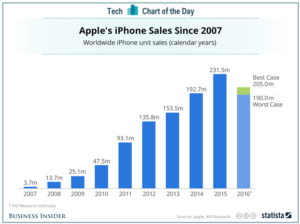By Roy Pankey
Eyes widen. Mouths drool. Kids ask for a raise in allowance. People wait in line for days. Sometimes fights break out over it. Everyone always wants it. It’s the latest, greatest iPhone. This thin, handheld device only makes a tiny splash if you drop it in a toilet (I would know!) but it has caused economic waves worldwide.
It’s hard to believe Apple unveiled its first iPhone a little more than a decade ago. They seem to have been around for much longer, as they’ve become almost an icon of American culture. Like all icons, though, the iPhone will eventually fade away and will be replaced by something else. And that day might not be so far away.
The iPhone has been the most profitable product by far for Apple, the company that makes the smartphone. Consumer spending on new iPhone models is so reliable that economists are now surprised if Apple’s stock price doesn’t go up. As of 2015, the iPhone was responsible for between 60 and 70 percent of Apple’s yearly profits. (The new models that year were the 6 and 6 Plus, costing a mere $750 by today’s standards.)
When looking at the iPhone’s impact on the country’s economy, Michael Feroli, an economist for JPMorgan Chase, told the New York Times a few years ago there was a definite correlation between releases of new iPhones and jumps in overall sales at electronics stores.
On a global level, smartphones are making their name known. The business accounted for almost six percent of Chinese exports. In terms of value added, iPhone exports in Ireland, where Apple has its European headquarters, have made up 25 percent of the country’s economic growth.
But all of this could mean serious trouble if the smartphone industry continues to shrink.
According to the April World Economic Outlook published by the International Monetary Fund (IMF) earlier this year, shipments of smartphones worldwide fell during 2017 for the first time ever.
“By decomposing the cycle from trend for Chinese exports of smartphones, regression results show that the trend is nonlinear and may have reached its peak in September 2015, suggesting that future global demand for smartphones may grow more slowly,” it wrote.
The iPhone industry is closely connected to several others associated with the making of the phone, including parts providers, factories where those parts are assembled, distributors who deliver the new phones, and the retailers who sell them. And that’s just to get the iPhones in the hands of consumers. App developers also depend on the smartphones for their business.
Earlier this fall, Apple released not two but three new iPhones. Best guesses say upwards of 90 million units have been made so far. Apple is expected to produce the same number during the first half of 2019. But what happens to 90 million iPhones if no one wants to buy them.
Sources:
Apple Insider – https://appleinsider.com/articles/18/04/19/apples-iphone-now-key-to-global-economy-growth-claims-imf
BGR – https://bgr.com/2018/07/10/iphone-9-iphone-11-vs-iphone-x-apple-discontinue-2017-model/


Leave a Reply
You must be logged in to post a comment.